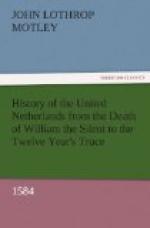When, at a later period, the plotting of Catholics, suborned by the Pope and Philip, against the throne and person of the Queen, made more rigorous measures necessary; when it was thought indispensable to execute as traitors those Roman seedlings—seminary priests and their disciples— who went about preaching to the Queen’s subjects the duty of carrying out the bull by which the Bishop of Rome had deposed and excommunicated their sovereign, and that “it was a meritorious act to kill such princes as were excommunicate,” even then, the men who preached and practised treason and murder experienced no severer treatment than that which other “heretics” had met with at the Queen’s hands. Jesuits and Popish priests were, by Act of Parliament, ordered to depart the realm within forty days. Those who should afterwards return to the kingdom were to be held guilty of high treason. Students in the foreign seminaries were commanded to return within six months and recant, or be held guilty of high treason. Parents and guardians supplying money to such students abroad were to incur the penalty of a preamunire—perpetual exile, namely, with loss of all their goods.
Many seminary priests and others were annually executed in England under these laws, throughout the Queen’s reign, but nominally at least they were hanged not as Papists, but as traitors; not because they taught transubstantiation, ecclesiastical celibacy, auricular confession, or even Papal supremacy, but because they taught treason and murder—because they preached the necessity of killing the Queen. It was not so easy, however, to defend or even comprehend the banishment and imprisonment of those who without conspiring against the Queen’s life or throne, desired to see the Church of England reformed according to the Church of Geneva. Yet there is no doubt that many sectaries experienced much inhuman treatment for such delinquency, both in the early and the later years of Elizabeth’s reign.
There was another consideration, which had its due weight in this balance, and that was the respective succession to the throne in the two kingdoms of France and England. Mary Stuart, the Catholic, the niece of the Guises, emblem and exponent of all that was most Roman in Europe, the sworn friend of Philip, the mortal foe to all heresy, was the legitimate successor to Elizabeth. Although that sovereign had ever refused to recognize that claim; holding that to confirm Mary in the succession was to “lay her own winding sheet before her eyes, yea, to make her, own grave, while she liveth and looketh on;” and although the unfortunate claimant of two thrones was a prisoner in her enemy’s hands, yet, so long as she lived, there was little security for Protestantism, even in Elizabeth’s lifetime, and less still in case of her sudden death. On the other hand, not only were the various politico-religious forces of France kept in equilibrium by their action upon each other—so that it was reasonable to believe that the House of Valois, however Catholic itself, would be always compelled by the fast-expanding strength of French Calvinism, to observe faithfully a compact to tolerate the Netherland churches—but, upon the death of Henry III. the crown would be legitimately placed upon the head of the great champion and chief of the Huguenots, Henry of Navarre.




